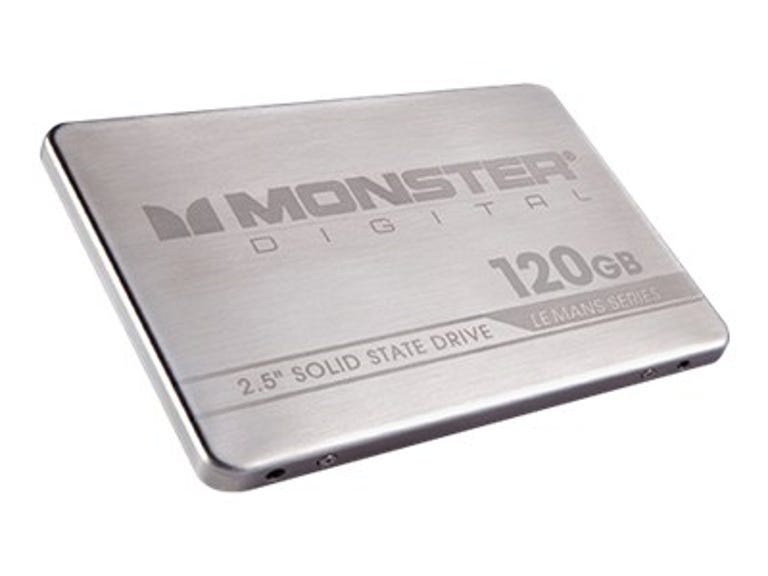 Why You Can Trust CNET
Why You Can Trust CNET Monster Digital Le Mans review: Monster Digital Le Mans
The Monster Digital Le Mans solid-state drive comes in a big package but fails to offer the kind of performance that you'd expect from its high price tag.
Editors' note: This review was updated on August 7 with an adjusted rating after more testing showed that the drive offered noticeably better performance than we originally found.
The Good
The Bad
The Bottom Line
If the Monster Digital name doesn't ring a bell when you think about solid-state drives, that's because the Le Mans is the company's first step into the realm of SSD storage.
And you can call it a baby step, since the Le Mans is only the third ultrathin standard SSD on the market I've reviewed, the other two being the
The Le Mans SSD is actually particularly friendly with desktop computers; it comes with a drive-bay adapter so it can fit in a 3.5-inch desktop drive bay. On top of that it also comes with a USB 3.0-to-SATA adapter and cloning software to make the migration from a regular hard drive to an SSD an easy job. Unfortunately all those extras still don't justify its cost; both the Intel and the RunCore currently cost significantly less per gigabyte and offer better performance.
That said, in terms of performance the Le Mans still makes a great upgrade for computers currently using a hard drive as the main storage. Still, you'll find almost any other SSD I've reviewed to be a better deal; make sure you check out the list of the current top five SSDs while shopping.
Design and features
| Drive type | 2.5-inch 7mm Internal drive |
| Connector options | SATA 3 (6Gbps), SATA 2, SATA |
| Available capacities | 80GB, 120GB, 240GB, 400GB |
| Product dimensions | 7mm thick, 2.5-inch standard |
| Capacity of test unit | 240GB |
| OSes supported | Windows, Mac, Linux |
The Monster Digital Le Mans comes in a big package, both in terms of physical size and what it has to offer. Inside the gift-box-style container, you'll find the SSD itself, a shiny and compact USB 3.0-to-SATA adapter, a USB 3.0 cable, a pen-shape mini screwdriver with multiple heads, a 3.5-inch drive-bay converter, mounting screws, and a CD of cloning software. There's also a large amount of packaging materials that you might appreciate the first time you open the box. After that, they will end up being a considerable amount of trash for the compact device they accompany. Basically the new SSD comes with more than you need from an internal drive, in rather excessive packaging.
The drive itself is very shiny, with an aluminum casing. It's actually so nice that you might wish you could use it as an external drive instead of an internal one. And you can use it as one when coupled with the included adapter. Obviously, though, you'll just want to use it that way for the cloning process. The Le Mans would make a very expensive external drive. Well, it makes an expensive internal drive, too, but more on the pricing below.
As an ultrathin drive, the Le Mans is 7mm thick, as opposed to the 9.5mm of a regular hard drive, with the rest of the measurements being exactly the same as a standard 2.5-inch drive. This means it will fit in all standard drive bays, so it can be used in an ultrabook or a regular laptop. When mounted on the included drive-bay converter, it will also fit nicely inside a desktop computer.
Out of the box, the Monster Digital Le Mans is not formatted and doesn't contain any data. This is actually a good thing; it makes the cloning process faster since you don't need to erase it first. In the unlikely case that you choose to use it as an external drive, you'll need to format it, which is quite easy to do. The drive supports SATA 3 (6Gbps) but also worked with the SATA 2 (3Gbps) standard. In my testing, it worked with the Mac, PC, and Linux platforms.
Cost per gigabyte
When it comes to SSDs, the pricing is always the biggest concern, and the Le Mans fails in this regard, being arguably the most expensive on the market. The drive costs about $330 for 240GB or $200 for 120GB making it cost around $1.50 per gigabyte. Comparatively, the Intel 520 series costs just around $1 per gigabyte and most other SSDs cost even less than that. It seems that the Le Mans is going against the trend of SSD pricing, going higher instead of lower.
Performance
In my testing, the Monster Digital Le Mans wasn't slow, but it didn't impress, either.
When used as a secondary drive, where it could show off its top performance, the drive registered about 178MBps in copying speed, compared with the 230MBps of the Intel 520 series. When used as the main drive of the test computer and performing both read and write duties at the same time, it scored just about 121MBps, about average among its peers.
Obviously, the strength of an SSD is not in raw data transfer but in random access, as in the performance of applications. And in this case the Le Mans did quite well, allowing applications -- even resource-heavy ones -- to start up very quickly. The drive also cut down the time it took for the test computer to boot up and shut down. The machine woke up from sleep mode instantly.
(Shorter bars indicate better performance)
| Shutdown | Boot time |
(Longer bars indicate better performance)
| As secondary drive | As OS Drive |
Conclusion
With good performance and expensive pricing, the Monster Digital Le Mans doesn't make an ideal upgrade. If you can afford it, however, it will give a great performance improvement if your system currently uses a traditional hard drive.


